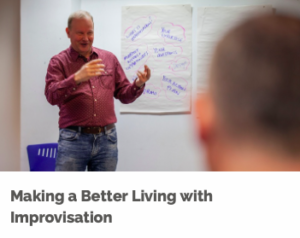If you want to be better at anything, pay attention to the critical variables. That’s the most brilliant insight from Tim Gallwey’s Inner Game work.
So to improve as a public speaker you need to discover your critical variables. Critical variables are aspects of your performance as a speaker that you can change and that relate directly to how well you are doing.
In one of Tim’s examples, he asks us to, ‘Imagine you are throwing hoops towards a target with eyes shut. How do you assess – before looking to check – whether the throw was short or long, left or right?’ He wonders whether we can tell from the speed at which our arm moves during the throw. If so, then arm speed would be a critical variable.
Now let’s add a coach to the mix. One of the coach’s tasks is to build the non-judgemental awareness of the coachee towards any critical variable of the activity. An experienced coach may well have enough technical knowledge to already know what some of those are: In some sports, for example, experts know that ball trajectory is more important than spin. In other cases, the coach and coachee work out together what’s most effective.
For many public speakers, one critical variable is how nervous they feel. How do you know that you are nervous? Perhaps there’s shaking. If so, how much, on a scale of 1-10? If we can quantify at one level, we’ll know when it’s improved or worsened. And we can keep exploring for other variables… Can you detect your heart rate or hear your tone of voice?
If these internal states prove elusive, then direct your attention outwards. Consider the audience and their responses, particularly any interactions between presenter and audience.
Early in your presentation you might look at the back rows and identify who is wearing glasses – a detail. You can note anyone who has blue eyes. You might find the most scary person – or more helpfully if your perception of the friendliness of your audience is a critical variable – identify the friendly faces. Any of these are likely to help, because they draw your attention to what’s happening in the presentation space.
How often and loudly are people laughing? That’s clearly an important metric for a comedian. How many questions are they asking? That’s worth counting if it’s an indicator for you of interest or engagement or audience members wanting to know more.
In every instance, Gallwey advises keeping judgement suspended by confining your quest to increasing awareness of what is; not what you think should or shouldn’t be. That means favouring questions along the lines of ‘Where is x, y, z?’ Or ‘What did you notice? In your body, in your shoulder?’ Once that information is flowing, then next you can make choices. And by this point, it’s the player in charge, not the coach.
This is a good fit with the Solution-Focused approach, in which there’s less looking to the coach for approval or for technical topic expertise, and more as a witness tasked with drawing attention to how various strategies are working for the client, and prompting the client to notice what’s useful for them. The answers naturally vary from individual to individual, so it is dangerous for the coach (and the client for that matter) to have too strong a sense beforehand of what will be right, as that may cloud our appreciation of significant, in-the-moment difference.
What critical variables can you focus on to improve your performance? Find out how our Inspirational Presenter course can equip you with a range of sophisticated techniques to make the most of your abilities, so you can excel on the platform and in front of any audience.



